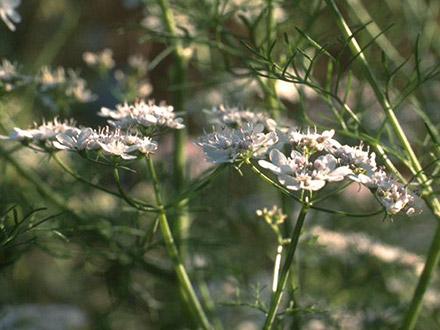Botanical name
(True) Caraway - Carum carvi L.
Family
Apiaceae
Common name
Meridian fennel, Persian cumin
Information about the plant
The biennial caraway is found scattered in the wild all over Europe and Asia. It is cultivated for its use as a spice in Holland, eastern Germany, Poland, and Egypt. The genus name comes from the Greek "karon" (= seed), derived either from the Greek ”kara“ (= head, umbel) or from the Greek “kar” (= louse), because of its lice-like appearance.
In its first year, it grows a single rosette from seed; in its second year, the 2 to 3-fold pinnate leaves with narrow leaflets, grow out of an up to 1 m tall, branched stem. It flowers from May to July, with numerous small white to pink flowers arranged in 8 to 16-rayed umbels. The fruits are brown when ripe, 3 mm to 6 mm long with 5 bright, angular protruding ribs. It is similar to all Apiaceae with "double achenes" which easily split into two separate fruits (achenes) even before autumn.
Medicinally used parts of plants (herbal drug)
The ripe fruits with their typical caraway scent, are used. The aroma is clearly perceived when rubbed and is created by the essential oil contained in the fruit.
The essential oil (caraway oil - Carvi aetheroleum), obtained from caraway fruits by steam distillation, is also used.
The commercially available drug comes from cultivations in the Netherlands, Poland, and Egypt.
Constituents of the herbal drug
Caraway fruits contain essential oil ("caraway oil") with D-carvone, which is responsible for the typical aroma. They also contain fatty oil, proteins and carbohydrates. Caraway oil contains 45-65% D-carvone, as well as limonene and other monoterpenes.
Quality of the drug
The quality of the following drugs or drug preparations is specified in the European Pharmacopoeia (Ph. Eur.):
- Caraway (Carvi fructus)
- Caraway oil (Carvi aetheroleum)
Medical applications
Recognised medical use
The HMPC has classified caraway and caraway oil as traditional herbal medicinal products (see “Traditional use”).
ESCOP: Caraway and caraway oil: to relieve digestive complaints such as flatulence, bloating and gastrointestinal spasms; caraway oil can also be used externally in children (rubbed into the lower abdomen). This area of application is based on findings from long-standing use.
Traditional use
The HMPC has classified caraway and caraway oil as traditional herbal medicinal products (Article 16a of Directive 2001/83/EC). Based upon long-standing use, caraway and caraway oil can be used for the relief of problems of the digestive system such as bloating and flatulence.. Caraway oil can also be used externally as a rub in the abdominal area in an appropriate preparation (e.g. ointment).
Herbal drug preparations in finished dosage forms
- Crushed caraway fruits as tea, also in tea infusion bags
- Alcoholic extracts in drops
- Dry extracts in coated tablets
- Caraway oil in enteric-coated capsules or liquids
Dosage
Prepared drugs: see patient information leaflet.
Tea: drink 1 cup of warm caraway tea several times a day.
Caraway oil: take 3 – 5 drops on a lump of sugar or water, several times a day. For abdominal rubbing: 10% solution in olive oil or another oil.
Preparation of a tea
Pour 150 ml of hot water over 1 to 5 g of freshly crushed caraway (do not boil!), let it stand for 10 to 15 minutes, then strain. To enhance the effectiveness, caraway should be crushed just before preparing the tea or coarsely powdered, so that the essential oil can be released into the tea.
Notes
In case of existing allergies to Apiaceae plants (e.g. fennel, caraway, celery, coriander, or dill), caraway preparations must be avoided. People with liver damage or bile problems should not use caraway. Long-term intake of caraway oil can lead to liver and kidney damage.
No safety studies are available on the use of caraway during pregnancy or lactation; use in children under 12 years of age is not recommended due to a lack of evidence.
Caraway oil should not be taken by children and adolescents under the age of 18, but there are no restrictions on external use (rubbing into the skin).
Side effects
None known.
Interactions
None known.
References
Herbal drug monographs
HMPC (2015, 2020), ESCOP (2019)
Further literature
Commentary on the European Pharmacopoeia (Caraway, No. 1080; Caraway oil, No. 1817)


